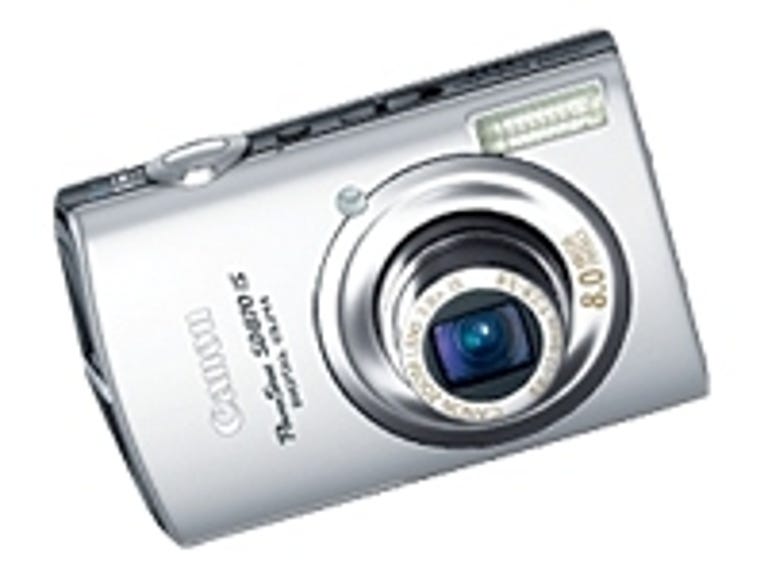 Why You Can Trust CNET
Why You Can Trust CNET Canon PowerShot SD870 IS review: Canon PowerShot SD870 IS
While the Canon PowerShot SD870 IS doesn't have an optical viewfinder or manual exposure controls, it captures beautiful images with its wide, 3.8x optical zoom and ranks among the top compact cameras we've seen.
Each fall a barrage of new cameras hits the market, anticipating the year-end holidays. This year's batch of Canons includes the PowerShot SD870 IS. From its model number, you might think that it's a follow-up to the SD850 IS, but with its wider-than-normal, 28mm-to-105mm, f/2.8-to-f/5.8, 3.8x optical zoom lens, it's really more of a successor to the SD800 IS. Aside from a step up to an 8.3-megapixel CCD sensor, a larger 3-inch, 230,000-pixel LCD, and Canon's new Digic III processor, there's not much different in the SD870 IS other than some nice cosmetic enhancements. Along with the new processor comes Canon's Advanced Face Detection, which can pick out up to nine faces in a frame and use the faces to set autofocus and exposure.
The Good
The Bad
The Bottom Line
Possibly the saddest change with this new model is that Canon omitted an optical viewfinder from the SD870 IS. This was probably done to make room for the larger screen, but it's an unfortunate compromise. On the upside, Canon spruced up the look of the camera's back, making it almost identical to the back of the SD750. This includes the newer version of Canon's multicontroller pad. It's more responsive than the pad on the SD800 IS, and a raised ring around the edge gives it a better feel. Plus, when you rest your thumb in any particular direction on the pad, a graphic appears on the LCD to show you what you'd do if you press fully. This helps you to keep your eyes on the screen when you have to change a setting while shooting.
Probably the only real ergonomic flaw on the SD870 IS is that there's no convenient place to rest your thumb. So, while all the shooting controls can be accessed through buttons on the right side of the camera, one-handed shooting can be annoying as you're forced to put your thumb on top of the right edge of the LCD screen--thereby blocking some of what you're trying to frame in the picture. Though the camera's optical image stabilization (hence the IS in the name) should help keep things steady, you may welcome the use of a second hand, since the SD870 IS weighs in at a somewhat hefty 6.4 ounces, with the battery and an SD card installed.
As usual with Canon's Digital Elph cameras, you won't find any manual exposure controls. Instead you have to rely on the camera's exposure compensation if you want to tweak the camera's automatic exposure, or resort to one of the camera's 10 scene modes to handle out-of-the-ordinary shooting scenarios. Flash exposure compensation lets you control the output of the flash, so the flash doesn't overpower your subjects if you're too close--a nice touch that's not found in all compact cameras.
We were very impressed by the SD870 IS's performance in our lab tests. It took the camera 0.9 second to start up and capture its first JPEG. Thereafter, the camera took 1.6 seconds between subsequent JPEGs with the flash turned off, and 2.4 seconds between JPEGs with the flash turned on. Shutter lag measured a stunning 0.4 second in our high-contrast test and 0.7 second in our low-contrast test, which respectively mimic bright and dim shooting conditions. In our continuous shooting test, the SD870 IS captured 1.3 frames per second regardless of image size or compression.
The PowerShot SD870 IS yields very high-quality images with accurate colors and tons of detail, and which are very clean at lower ISOs. The automatic white balance does a very good job of neutralizing colors in different kinds of lighting, but with incandescent lighting, its images have a very slight warm cast. Some people prefer this, since it gives a natural look, as incandescent lighting does give off a warm glow. However, if you prefer a more neutral look in these situations, the tungsten preset does a great job of serving up neutral images.
Canon keeps ISO noise well under control through ISO 200. You probably won't notice much in the way of noise even when viewing ISO 200 images on your monitor, which tends to be more revealing of such noise than prints. At ISO 400, noise becomes readily apparent on monitors, but Canon's noise reduction algorithms manage to smooth it out so it doesn't take on that fine, snowy look that some cameras--including some older Canons--tend toward. Plus, most of this noise should become minimized when making inkjet prints. At ISO 800, noise is much more apparent and should show up in prints, but Canon does a good job of preserving some fine detail, and images show impressive shadow detail for such high sensitivity in a compact camera. Images at ISO 1,600 are very noisy with the SD870 IS, showing large, grainy noise. Most fine detail is lost, giving images a soft look, and a large portion of shadow detail goes by the wayside. Still, given that this camera has a small sensor, the results are somewhat impressive. The images may be usable for small prints, or for use at small sizes on the Web.
Canon's PowerShot SD870 IS is a worthy addition to the company's Digital Elph line. Experienced photographers looking for a pocket camera will lament the fact that the camera doesn't have any manual exposure controls, but if you don't feel the need to tinker with your camera's settings and aren't caught up in the pointless megapixel race, you'll likely be very pleased with this point-and-shoot.
(Shorter bars indicate better performance)
(Longer bars indicate better performance)
